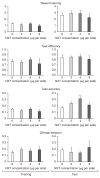Methylphenidate facilitates learning-induced amygdala plasticity
- PMID: 20208527
- PMCID: PMC2988577
- DOI: 10.1038/nn.2506
Methylphenidate facilitates learning-induced amygdala plasticity
Abstract
Although methylphenidate (Ritalin) has been used therapeutically for nearly 60 years, the mechanisms by which it acutely modifies behavioral performance are poorly understood. Here we combined intra-lateral amygdala in vivo pharmacology and ex vivo electrophysiology to show that acute administration of methylphenidate, as well as a selective dopamine transporter inhibitor, facilitated learning-induced strengthening of cortico-amygdala synapses through a postsynaptic increase in AMPA receptor-mediated currents, relative to those in saline-treated rats. Furthermore, local administration of methylphenidate in the lateral amygdala enhanced cue-reward learning through dopamine D1 receptor-dependent mechanisms and suppressed task-irrelevant behavior through D2 receptor-dependent mechanisms. These findings reveal critical and distinct roles for dopamine receptor subtypes in mediating methylphenidate-induced enhancements of neural transmission and learning performance.
Figures






Similar articles
-
Rapid strengthening of thalamo-amygdala synapses mediates cue-reward learning.Nature. 2008 Jun 26;453(7199):1253-7. doi: 10.1038/nature06963. Epub 2008 May 11. Nature. 2008. PMID: 18469802 Free PMC article.
-
Dopamine-induced plasticity, phospholipase D (PLD) activity and cocaine-cue behavior depend on PLD-linked metabotropic glutamate receptors in amygdala.PLoS One. 2011;6(9):e25639. doi: 10.1371/journal.pone.0025639. Epub 2011 Sep 27. PLoS One. 2011. PMID: 21980514 Free PMC article.
-
NMDA currents and receptor protein are downregulated in the amygdala during maintenance of fear memory.J Neurosci. 2003 Nov 12;23(32):10283-91. doi: 10.1523/JNEUROSCI.23-32-10283.2003. J Neurosci. 2003. PMID: 14614087 Free PMC article.
-
Dopamine D1-like receptors and reward-related incentive learning.Neurosci Biobehav Rev. 1998 Mar;22(2):335-45. doi: 10.1016/s0149-7634(97)00019-5. Neurosci Biobehav Rev. 1998. PMID: 9579323 Review.
-
Methylphenidate and the juvenile brain: enhancement of attention at the expense of cortical plasticity?Med Hypotheses. 2013 Dec;81(6):988-94. doi: 10.1016/j.mehy.2013.09.009. Epub 2013 Sep 17. Med Hypotheses. 2013. PMID: 24095262 Free PMC article. Review.
Cited by
-
Neurobiology of maternal regulation of infant fear: the role of mesolimbic dopamine and its disruption by maltreatment.Neuropsychopharmacology. 2019 Jun;44(7):1247-1257. doi: 10.1038/s41386-019-0340-9. Epub 2019 Feb 13. Neuropsychopharmacology. 2019. PMID: 30758321 Free PMC article.
-
Aversion hot spots in the dopamine system.Curr Opin Neurobiol. 2020 Oct;64:46-52. doi: 10.1016/j.conb.2020.02.002. Epub 2020 Mar 5. Curr Opin Neurobiol. 2020. PMID: 32146296 Free PMC article. Review.
-
Neurotensin orchestrates valence assignment in the amygdala.Nature. 2022 Aug;608(7923):586-592. doi: 10.1038/s41586-022-04964-y. Epub 2022 Jul 20. Nature. 2022. PMID: 35859170 Free PMC article.
-
High emotional reactivity is associated with activation of a molecularly distinct hippocampal-amygdala circuit modulated by the glucocorticoid receptor.Neurobiol Stress. 2023 Oct 16;27:100581. doi: 10.1016/j.ynstr.2023.100581. eCollection 2023 Nov. Neurobiol Stress. 2023. PMID: 37928820 Free PMC article.
-
A causal link between prediction errors, dopamine neurons and learning.Nat Neurosci. 2013 Jul;16(7):966-73. doi: 10.1038/nn.3413. Epub 2013 May 26. Nat Neurosci. 2013. PMID: 23708143 Free PMC article.
References
-
- Swanson JM, Lerner M, Williams L. More frequent diagnosis of attention deficit-hyperactivity disorder. N Engl J Med. 1995;333:944. - PubMed
-
- Aman MG, Vamos M, Werry JS. Effects of methylphenidate in normal adults with reference to drug action in hyperactivity. Aust N Z J Psychiatry. 1984;18:86–88. - PubMed
-
- American Psychiatric Association. Diagnostic and Statistical Manual of Mental Disorders. American Psychiatric Publishing; Arlington, Virginia, USA: 1994.
-
- Greenhill LL, et al. Practice parameter for the use of stimulant medications in the treatment of children, adolescents, and adults. J Am Acad Child Adolesc Psychiatry. 2002;41:26S–49S. - PubMed
Publication types
MeSH terms
Substances
Grants and funding
LinkOut - more resources
Full Text Sources

